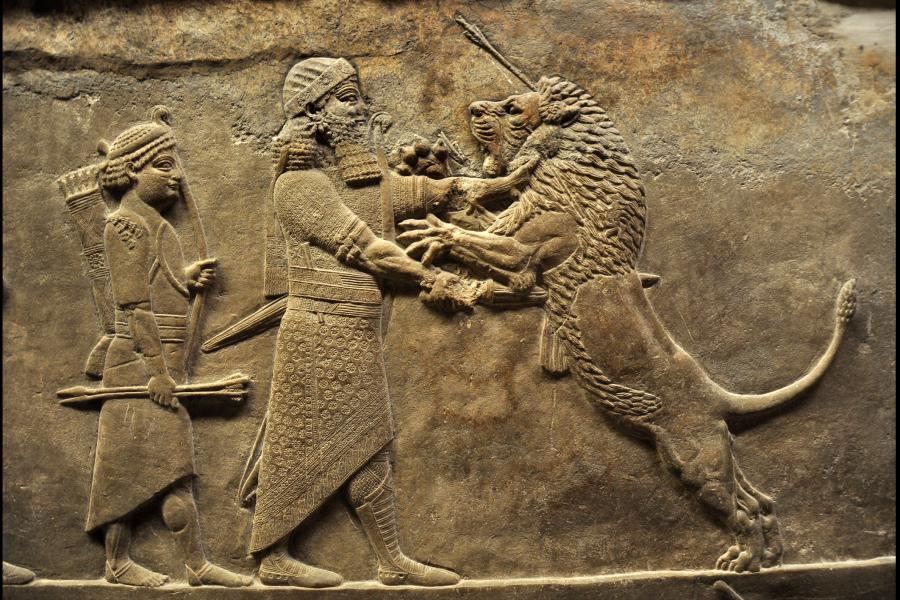What emotions do these images of animals evoke in you?


Lion
'Lion Hunt of Ashurbanipal'
645-35 BCE
unknown/unknowable
An Assyrian emperor slays an Asian lion.
More about this image-
Bright emotions
-
Not at all Extremely
-
-
Quiet emotions
-
Not at all Extremely
-
-
Heavy emotions
-
Not at all Extremely
-
-
Sombre emotions
-
Not at all Extremely
-
Species: Asiatic lion (Panthera leo leo)
Localton: Southern Asia
Conservation status: Endangered

Compare yourself to others
Choose different variables below, and see the patterns of response reflected in the circle of emotion above. Your responses are the coloured wedges. Others' responses are averaged in the spider graph of lines and dots.

Title: 'Lion Hunt of Ashurbanipal'
Creator: unknown/unknowable
Date: 645-35 BCE
Medium: Gypsum alabaster hall relief
Photographer: Carole Raddato
Copyright: Public domain
Assyrian warrior-king Ashurbanipal throttles a wounded lion, and calmly, resolutely. thrusts his sword through its chest. This image is a part of the epic gypsum alabaster hall relief called the Lion Hunt of Ashurbanipal, which decorated the halls of the North Palace of Nineveh, an ancient city-state in present day Iraq. The darkly beautiful images were commissioned by King Ashurbanipal (c.685-631BCE), remembered as the last of the great Assyrian kings, a fierce ruler who was also a dedicated patron of artworks and literature. It depicts the practices of captured Asiatic lions being hunted and slaughtered by the Assyrian royalty, and is currently displayed in the British Museum, after it was plundered from Ottoman Iraq in 1853. In these images, the blank formal, side-on depictions of humans, bereft of emotional expression, contrasting starkly with the incredibly emotive lions, each vibrantly captured in various shades of life and death.
The Asian lions that Ashurbanipal and his warriors slaughtered migrated out of Africa 700,000 years ago and were widely spread, from India in the east, across the Persian Empire, the Arabian peninsular and into Greece and other parts of South Eastern Europe. The Asian lion were purposely was driven to extinction, with the last known lion in Iraq being killed in the lower Tigris in 1918. Today, around 1000 Asian lions exist in and around a small pocket of forest of Gir National Park, in the Indian state of Gujarat.
The Asian lions more populous cousins live in scatted places across parts of sub-Saharan Africa, a tiny fraction of their former habitats. They like space, prefer savannahs, grasslands, scrubby flood plains, and open woodlands, and are not found in jungles or dense forests. A keystone, apex predator, this extremely powerful cat has the highest radio of muscles to body-weight among mammals, with a dense concentration of fast twitch muscles, giving it great speed and strength. The lion's ability, and occasional practice, of predating on humans surely contributed to people driving them to extinction, with their consumption of livestock being an equal driver.
It is hard to overstate the cultural significance of lions, they are one of the most widely recognised and used animal symbols, being of central significance to many religious and mythological practices, and -- as Ashurbanipal can attest -- they have long been hunted, prized trophies, as well as key attractions in circuses and zoos. Lions have great significant in places where they have never been native inhabits, such as Britain, such as via King Richard the Lionheart (1157-99), or China, with its Lion Dance having long been performed there, and beyond, for over a thousand years. This runs all the way through to *The Lion King* (1994), the highest-grossing traditionally animated film of all time, and its legions of spin offs and substandard remakes.





